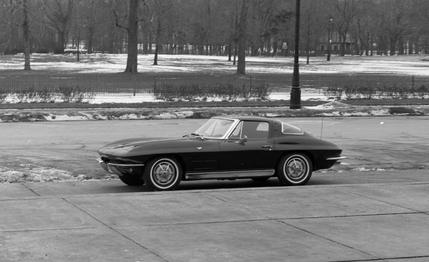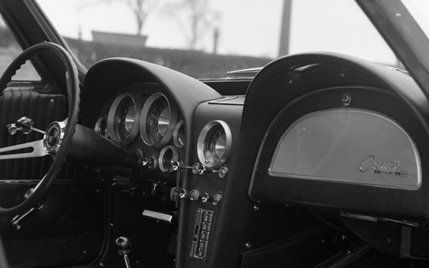 First Drive Review
First Drive Review
One glance at the new Corvette tells you that it is faster and sportier than its predecessors. And when you drive a Corvette Sting Ray, either the convertible or the fastback Sport Coupé, you find that the excitement is far more than skindeep. Hiding independent rear suspension under its sculptured tail, the Corvette is now second to no other production sports car in road-holding and is still the most powerful.
The biggest innovation this year is that the coupé is now a separate, distinct body rather than an alternative top for a basically open roadster. As is traditional with Corvette, both the coupé and the convertible are made of fiberglass. There is good reason to believe that the new coupé was inspired by the dramatic introduction of Jaguar's XK-E coupé at the Coliseum in April, 1961. GM personnel are known to have borrowed the keys to the Jaguar and come back late the night of opening day to measure and sketch it inside and out. Just as the XK-E coupé is faster than the roadster, so is the Sting Ray Sport Coupé faster than the convertible. With open exhausts, the coupé has exceeded 160 mph, and with full street equipment it will still be able to do a genuine 155, whereas the top speed of the convertible lies between 150 and 155, according to Zora Arkus-Duntov.
More prosaically—but very important—the seating position has been tremendously improved over previous Corvettes. The seats are farther back and so many adjustment possibilities are provided that any driver should be able to find a comfortable position. Straight-arm driving is at last possible, and visibility over the sloping hood is very good. From behind the wheel, the car looks and feels smaller than the "old" Corvette, and it is.

The wheelbase has been reduced from 102 to 98 inches, and the front track is down from 57 inches to 56.3, while the rear track has been reduced from 59 inches to 57. All of this makes it more nimble and more easily steered with precision.
When it was boosted to 327 bhp last year, it became obvious that the Corvette could not again be improved by merely adding power. With the chassis thus at its limit, it was decided to make improvements where they were needed most: in the frame and suspension. Zora Arkus-Duntov, H. F. Barr, and E. J. Premo of Chevrolet Engineering got together to build an all-new chassis, drawing extensively on their experience with the Corvette SS of 1957, the Sting Ray, and the CERV-1.
The geometry of the independent rear suspension has been directly derived from the open-wheel racing car prototype, CERV-1. There was no room on the '63 Corvette for coil springs as used on the CERV-1, so Duntov chose a transverse leaf spring and put it behind and below the differential housing.
Unsplined half-shafts with two universal joints each function as upper wishbones. Underneath each is a simple lateral control rod; driving and braking thrust are taken up by stamped-steel radius arms. The differential housing is bolted to the frame both front and rear.
Compared with the rigid axle of the 1962 Corvette, the new model has a lower rear roll center (8.13 inches above ground level against 9.0). This is the same as on the CERV-1, while the Dion-suspended SS and Sting Ray had roll centers 8.0 inches above the ground.